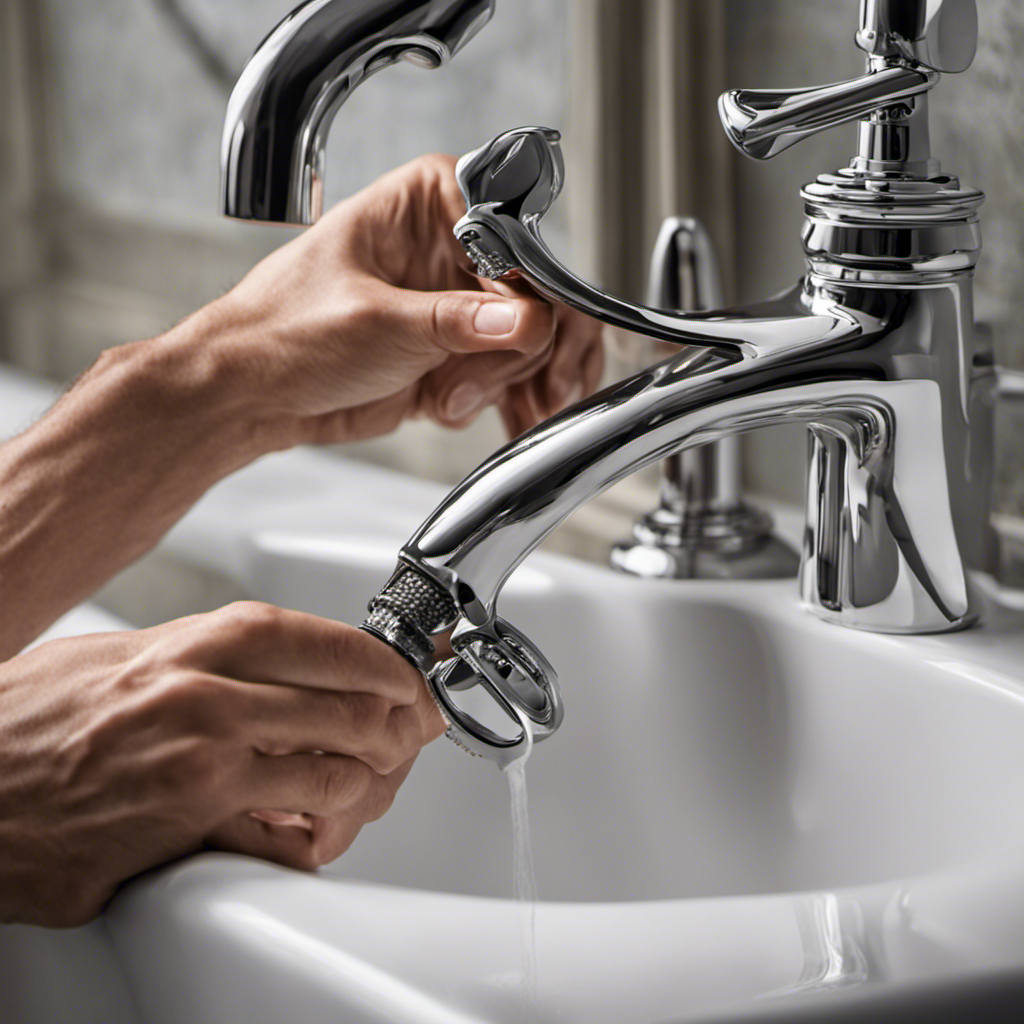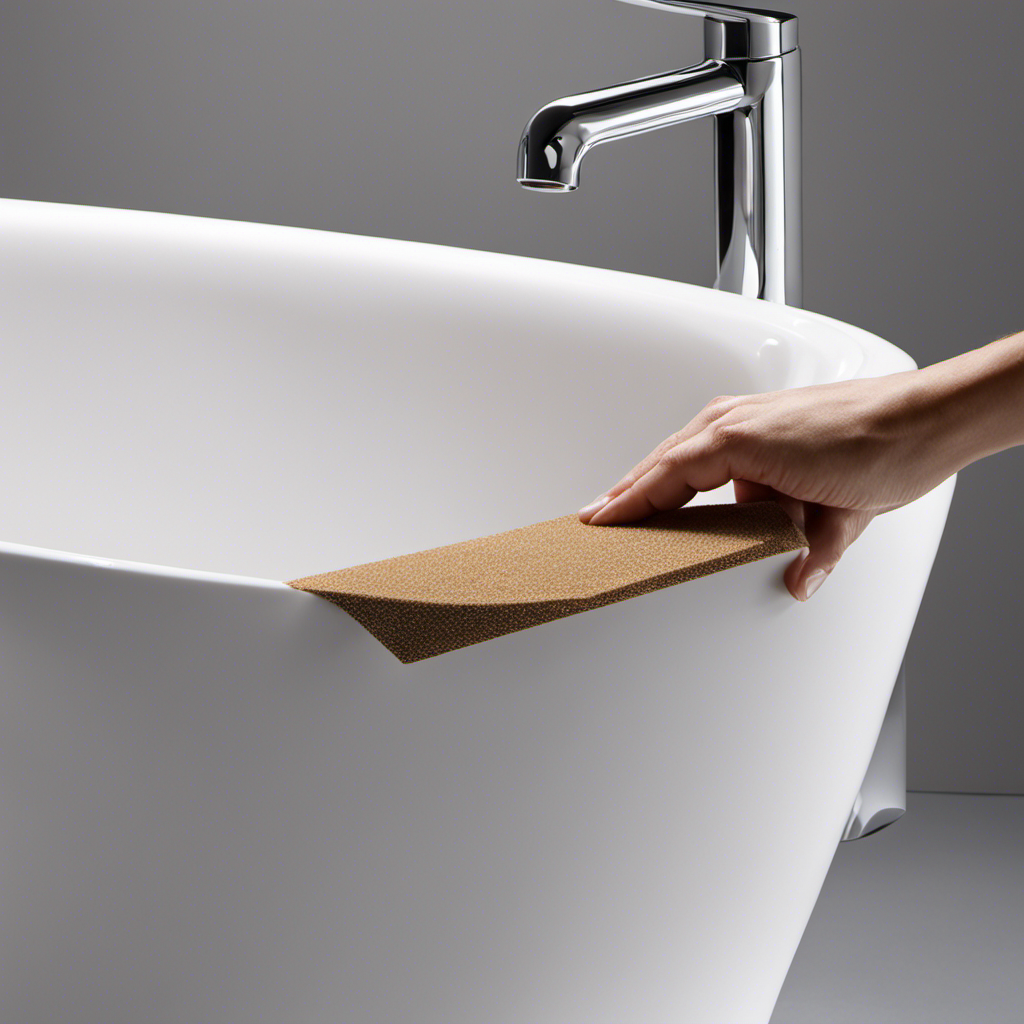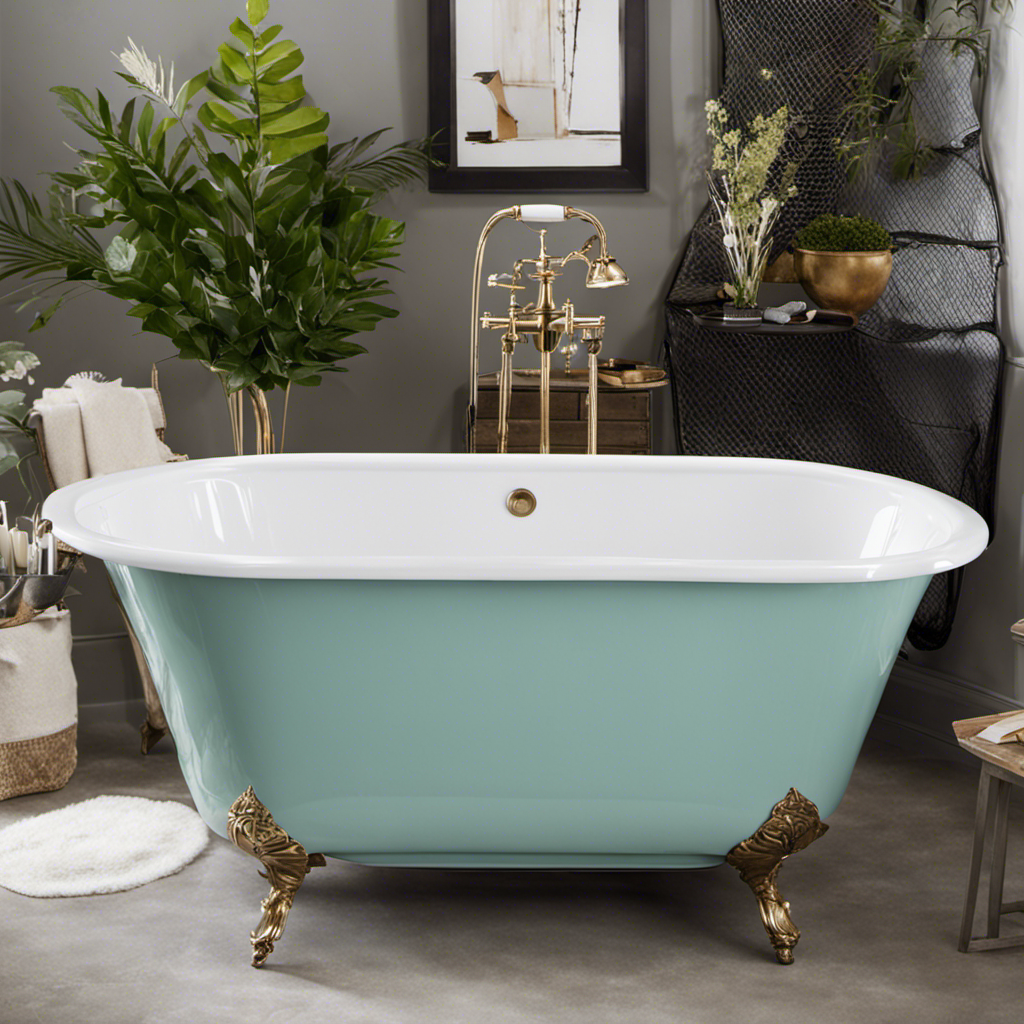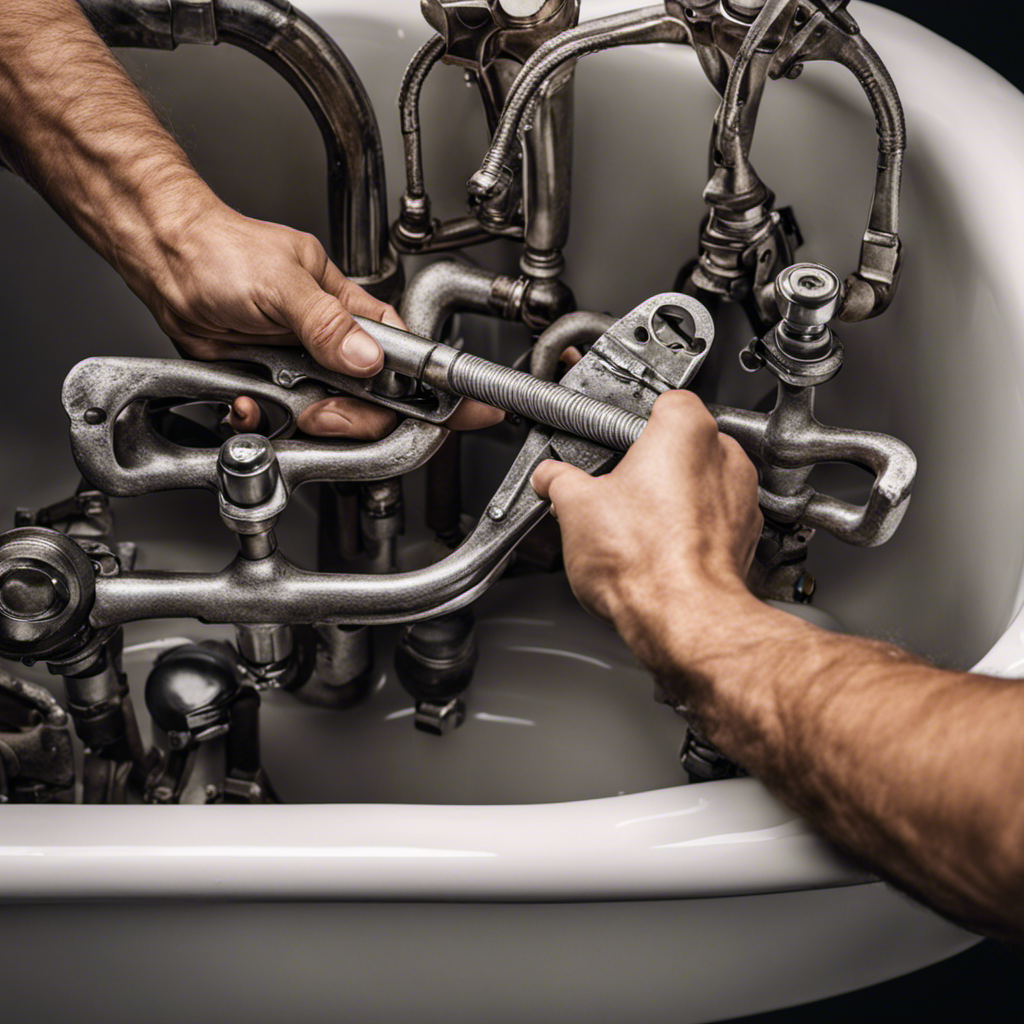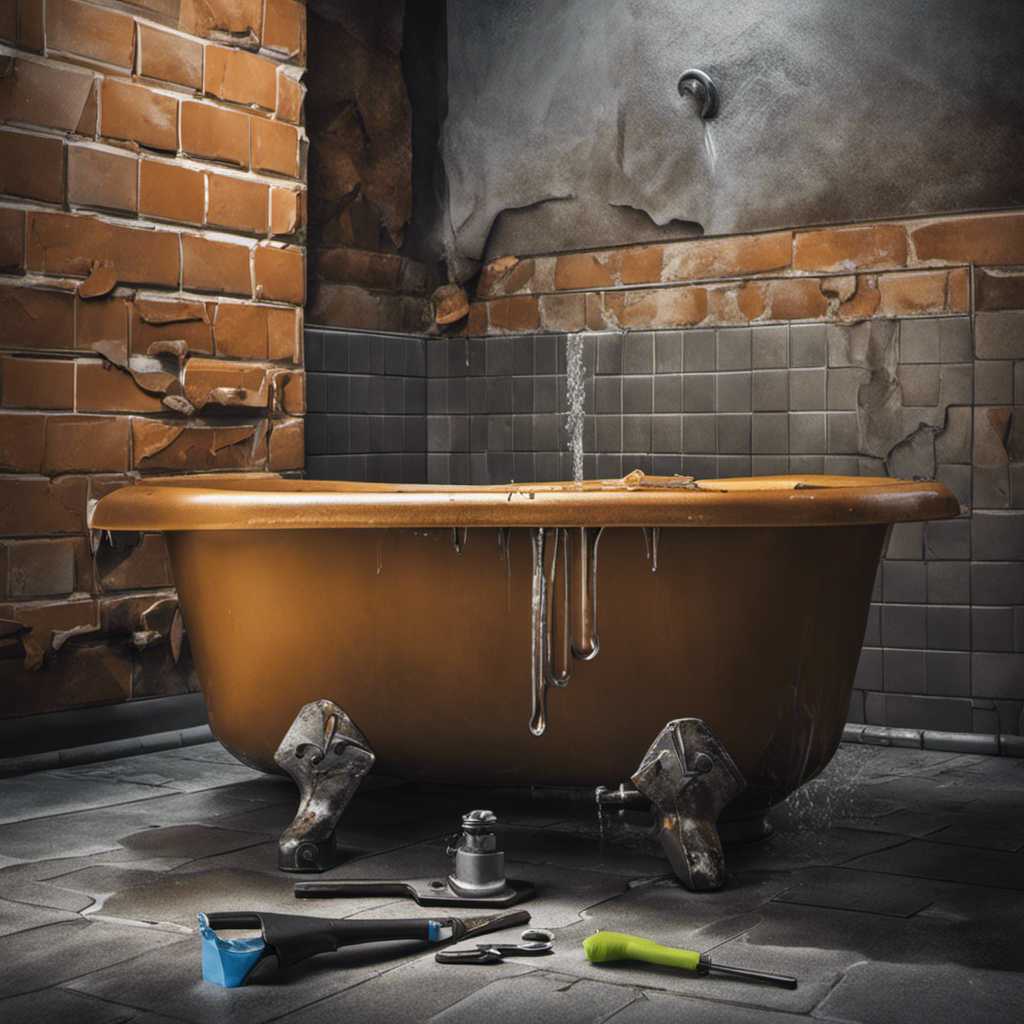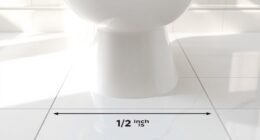Did you know that a leaking bathtub faucet can waste up to 3,000 gallons of water per year?
As a homeowner, it’s important to know how to repair a bathtub faucet to save water and money.
In this article, I will guide you through the process of fixing common bathtub faucet issues.
From disassembling the faucet to repairing leaks and testing your repairs, you’ll become a DIY plumbing expert in no time.
So let’s get started on restoring your bathtub faucet to its former glory!
Key Takeaways
- There are different types of bathtub faucets and finishes, including compression, cartridge, ball, and disc faucets, as well as chrome, brushed nickel, and oil-rubbed bronze finishes.
- The tools needed for bathtub faucet repair include an adjustable wrench, screwdriver, and pipe wrench, and it is important to turn off the water supply and follow the manufacturer’s instructions.
- Common issues with bathtub faucets include dripping, low water pressure, leaking around the handle, screeching noise, and temperature fluctuations. These can be troubleshooted by checking water pressure, inspecting the cartridge or valve, and testing the hot and cold water supply.
- When repairing leaks in a bathtub faucet, it is necessary to turn off the water supply, identify faulty parts such as washers or O-rings, and disassemble and reassemble the faucet. Proper reassembly techniques, thorough functionality testing, and avoiding common mistakes are important for successful repairs.
Types of Bathtub Faucets
Now, let’s talk about the different types of bathtub faucets you might encounter.
When it comes to faucet installation tips, it’s crucial to understand the various types available in the market. The most common types are compression faucets, cartridge faucets, ball faucets, and disc faucets.
Compression faucets are affordable but prone to leaks and require regular maintenance.
Cartridge faucets are reliable and easy to operate, with a single handle for both hot and cold water.
Ball faucets have a rotating ball mechanism that controls water flow and temperature.
Lastly, disc faucets are durable, low-maintenance, and provide precise water control.
Another aspect to consider is bathtub faucet finishes, such as chrome, brushed nickel, or oil-rubbed bronze. These finishes not only enhance the aesthetics but also affect durability and ease of cleaning.
Tools Needed for Bathtub Faucet Repair
To fix it, you’ll need a few tools like an adjustable wrench, a screwdriver, and a pipe wrench. These tools are essential for bathtub faucet repair.
The adjustable wrench is necessary for loosening and tightening various fittings, while the screwdriver is used to remove screws and access the inner components of the faucet. The pipe wrench is particularly useful for removing the faucet handle and other stubborn parts.
When performing a bathtub faucet repair, it’s important to follow a few tips. Firstly, make sure to turn off the water supply before starting any work. Secondly, take your time and carefully inspect the faucet for any damaged or worn-out parts. Lastly, always refer to the manufacturer’s instructions or seek professional help if needed.
Using the right tools and following these tips will help ensure a successful bathtub faucet repair.
Identifying Common Bathtub Faucet Issues
If you’re experiencing any issues with your bathtub faucet, there are a few common problems you can look out for. Identifying these issues early can help prevent further damage and save you from costly repairs. Here are some common bathtub faucet issues and their potential causes:
| Problem | Possible Cause | Solution |
|---|---|---|
| Dripping faucet | Worn out washers or seals | Replace washers or seals |
| Low water pressure | Mineral deposits or clogged aerator | Clean or replace aerator |
| Leaking around handle | Loose or damaged handle | Tighten or replace handle |
| Screeching noise | Loose or worn out parts | Tighten or replace parts |
| Temperature fluctuations | Malfunctioning mixing valve | Replace mixing valve |
Regular bathtub faucet maintenance is essential for preventing future faucet problems. Ensure that you clean your faucet regularly, removing any mineral deposits or debris. Also, check for and repair any leaks promptly to prevent water damage. Finally, be gentle when using the faucet handles to avoid excessive wear and tear. By following these maintenance tips, you can extend the lifespan of your bathtub faucet and avoid costly repairs in the future.
Step-by-Step Guide to Disassembling a Bathtub Faucet
In order to successfully disassemble a bathtub faucet, there are several tools and materials that you’ll need.
Some of the required tools include an adjustable wrench, a screwdriver set, plumber’s tape, and a replacement cartridge or O-rings.
Additionally, it’s important to troubleshoot common issues that may arise during the disassembly process. These issues can include stuck or corroded parts, leaks, or difficulty removing the faucet handle.
Required Tools and Materials
You’ll need a few tools and materials to repair your bathtub faucet. When it comes to bathtub faucet repair, having the right tools is essential. Here are some common bathtub faucet problems and the tools and materials you’ll need to fix them.
One common issue with bathtub faucets is a leaking or dripping faucet. To fix this, you’ll need an adjustable wrench, a screwdriver, and replacement parts such as O-rings, washers, and cartridges.
Another common problem is a squeaky faucet handle. To fix this, you’ll need a lubricant like silicone grease.
If your bathtub faucet is not producing enough hot water, you may need to replace the cartridge or adjust the water heater temperature. In this case, you’ll need a cartridge removal tool, an adjustable wrench, and a thermometer.
Troubleshooting Common Issues
To troubleshoot common issues, start by checking for any visible leaks or drips in your bathtub. This could indicate a problem with the faucet itself or with the water supply lines. If you notice any leaks, it’s important to address them promptly to prevent further damage.
Here are some troubleshooting steps for bathtub faucet maintenance:
-
Check the water pressure: Low water pressure can be caused by a clogged aerator or a faulty valve. Remove the aerator and clean it to remove any debris. If the water pressure is still low, you may need to replace the valve.
-
Inspect the cartridge or valve: The cartridge or valve controls the flow of water in the faucet. If it is worn out or damaged, it can cause leaks or inconsistent water flow. Consider replacing the cartridge or valve if necessary.
-
Test the hot and cold water supply: If only one side of the faucet is not working properly, there may be an issue with the corresponding water supply line. Check the shut-off valves and ensure they are fully open.
Repairing Leaks in a Bathtub Faucet
When repairing leaks in a bathtub faucet, start by turning off the water supply to avoid any accidents. Leaks can be caused by various issues, such as worn out washers or damaged O-rings. To fix the leak, you will need to disassemble the faucet and replace the faulty parts.
Here is a step-by-step guide to help you repair your bathtub faucet:
- Turn off the water supply.
- Remove the faucet handle by unscrewing the set screw.
- Inspect the handle for any cracks or damage. Replace if necessary.
- Use a wrench to remove the bonnet nut and expose the cartridge.
- Replace any worn-out washers or O-rings.
- Reassemble the faucet and turn on the water supply to check for leaks.
Reassembling and Testing Your Repaired Bathtub Faucet
When it comes to repairing a bathtub faucet, proper reassembly techniques are crucial for ensuring that the faucet functions correctly and does not leak.
This involves carefully following the manufacturer’s instructions and using the correct tools and materials to reassemble the faucet components in the correct order.
Once the faucet is reassembled, thorough functionality testing should be conducted to ensure that it operates smoothly and without any issues.
This includes checking for leaks, testing the hot and cold water flow, and ensuring that the handle and other controls function properly.
Proper Reassembly Techniques
Make sure you’ve correctly reassembled all the parts before testing the bathtub faucet. Proper reassembly techniques are crucial to ensure that your repaired faucet functions properly. Here are some common mistakes to avoid:
- Incorrect placement of washers and O-rings: Ensure that you place the washers and O-rings in their correct positions to prevent leaks.
- Over-tightening: It’s important to tighten the faucet components securely but avoid over-tightening, as this can cause damage to the parts.
- Misalignment of threads: When reassembling, make sure that the threads on the valve stem align correctly with the threads in the faucet body to ensure a secure fit.
Thorough Faucet Functionality Testing
To ensure proper functionality, it’s important to thoroughly test the reassembled bathtub faucet. Regular inspection and testing can help prevent potential issues and ensure optimal performance. When testing your bathtub faucet, start by turning on the water and checking for any leaks or drips. Make sure the hot and cold water handles are working correctly, allowing for easy adjustment of water temperature. Additionally, check the water pressure to ensure it is consistent and adequate.
If you notice any problems during the testing process, it’s important to address them promptly to avoid further damage. By regularly inspecting and testing your bathtub faucet, you can maintain its functionality and prevent costly repairs down the line.
Conclusion
After carefully disassembling and repairing my bathtub faucet, I couldn’t wait to see if my efforts paid off.
Slowly, I turned the handle, anticipation building inside me.
And then, a miracle happened. The faucet didn’t leak anymore! I couldn’t believe it.
All those steps, all that hard work, it had finally paid off. I felt like a DIY superhero, ready to take on any plumbing challenge that came my way.
So if you’re facing a leaky bathtub faucet, don’t despair. With the right tools and a little bit of know-how, you too can conquer the task and enjoy the satisfaction of a job well done.
